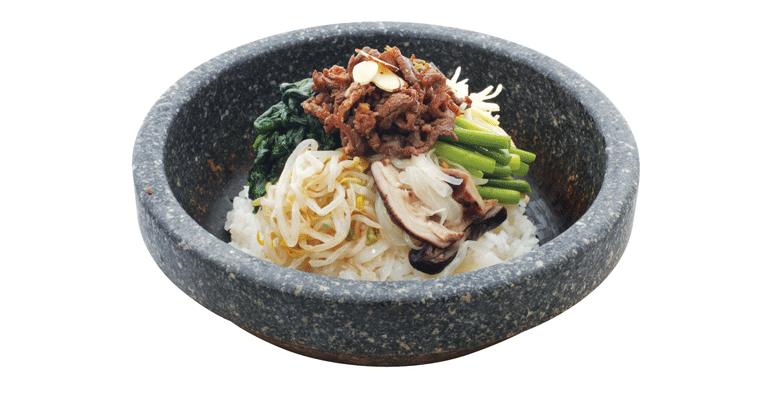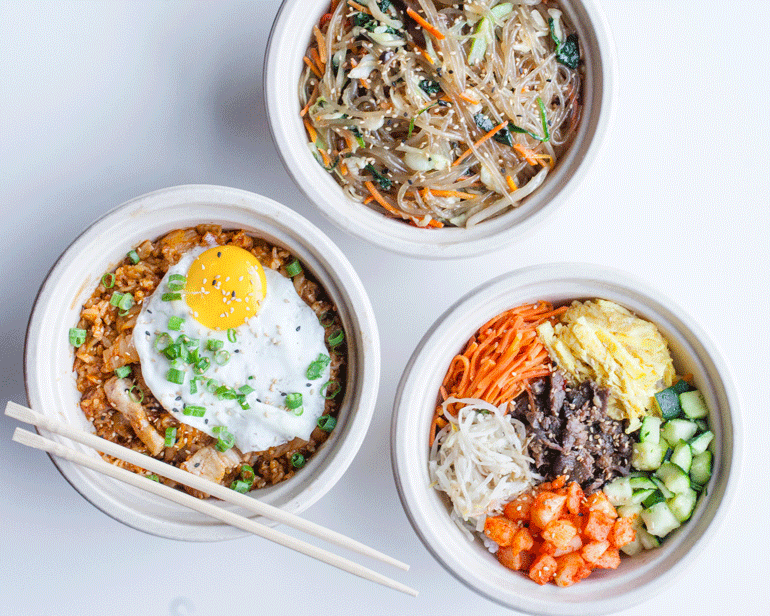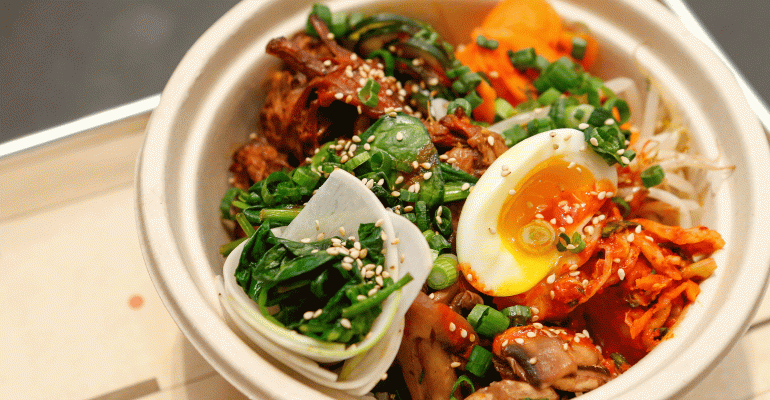Until a few years ago, kimchi was little known outside Korean communities, but now the pickled vegetable — usually cabbage — is a mainstay at trend-forward restaurants. Likewise, the spicy-sweet fermented chile paste gochujang, until very recently a mystery to most Americans, is becoming increasingly widespread.
Korean ingredients are now mentioned on 5.2 percent of all menus, a 71-percent increase since 2013, according to menu research firm Datassential. So, it stands to reason that Korean restaurants have expanded beyond Korean neighborhoods, and now Korean fast-casual concepts are popping up across the country.
Some focus on a single, traditional item, such as Korean fried chicken — dusted in cornstarch and double-fried — or the rice dish bibimbap, comprised of vegetables and sometimes marinated meat and often topped with a fried egg. Others, evoking Los Angeles chef Roy Choi’s Kogi BBQ truck, fuse Korean and Mexican cuisines.
The undisputed fast-casual Korean leader is Bibibop Asian Grill. The 29-unit bibimbap chain based in Columbus, Ohio, is owned by Gosh Enterprises, which also owns the 500-unit Charleys Philly Steaks sandwich chain. Last year, it roughly doubled in size by buying the leases of 15 ShopHouse Southeast Asian Kitchen locations after owner Chipotle Mexican Grill Inc. abandoned the concept.

Dak & Bop
Based: Houston
Units: 1
Opened: 2014
Average check: $10-$15
Owners: Jason and Mary Cho
Dak & Bop isn’t afraid to acknowledge that it’s in Texas. Although specializing in Korean twice-fried chicken in a choice of five sauces — soy and garlic, hot and spicy, medium spicy (a mix of soy-garlic and hot-spicy), Sriracha-honey-lime or Buffalo hot — the restaurant also has Tex-Mex specialties such as barbecue pulled pork, empanadas, eloté and three kinds of macaroni and cheese — including one with the marinated Korean beef bulgogi. Bao buns can be stuffed with fried chicken, carnitas, pulled pork or “K-Philly Cheesesteak,” which is made with bulgogi, grilled onions, white cheddar cheese and citrus aïoli and is served with a side of kimchi.
Fries can be topped with garlic-truffle oil, shredded Parmesan or both, or guests can order kimchi fries, which are topped with a four-cheese blend, spicy mayonnaise, Sriracha, house D&B sauce, caramelized kimchi, green and white onions, cilantro and roasted sesame seeds.
The restaurant also has an active bar scene and offers craft cocktails and beer.

Seoul Taco
Based: St. Louis
Units: 5
Opened: 2011
Price range: $10 or less
Owner: David Choi
Like Roy Choi’s famous Kogi BBQ truck of Los Angeles, which arguably launched both the food truck and Korean food trends, this five-unit chain also started as a food truck and also serves Korean flavors in recognizable Mexican forms, such as the Seoul Taco Burrito, which is stuffed with kimchi fried rice, lettuce, cheese, carrots, green onions, sour cream, proprietary “Seoul” sauce and a choice of bulgogi beef, spicy pork, chicken or seasoned tofu. Tacos, quesadillas and nachos are available, too, topped with Korean staples like green onions, sesame seeds and kimchi, as well as Tex-Mex ingredients such as cheese and sour cream.
Founded in St. Louis by chef David Choi (no relation to Roy Choi), the chain operates in Chicago and Champaign, Ill., and the Missouri cities of Columbia, Chesterfield and St. Louis.

Bibigo
Based: Commerce, Calif.
Units: 9 in the U.S.
Opened: 2010
Price range: $7.95-$13
Owner: Bibigo International LLC
Bibigo is a global brand founded by Korean food conglomerate CJ. The concept takes the classic Korean dish bibimbap — rice topped with meat and vegetables — and applies the fast-casual treatment of near infinite customizability. Guests choose whether to have their meal in a bowl, in a more impressive-looking hot stone, or in a larger box with more protein and a side of fried dumplings. Then they choose a base of white, brown or kimchi rice, noodles or salad. They can top that with vegetables such as kale, carrots, green beans, kimchi and pickled radish, followed by a choice of protein, including the classic bulgogi, thinly sliced short ribs called galbi, chicken in gochujang, chicken with soy-garlic sauce, spiced pork or tofu.
Six different sauces are available, from sesame and hot sauce to citron-soy and yellow curry, and toppings such as fried onions, sesame seeds, seaweed or a fried egg.
When the first Bibigo opened in 2010, owner CJ said it planned to open 200 locations across the country. Currently, there are eight locations in Los Angeles and one in San Diego. A new unit was expected to open in West Los Angeles in May that will test a new interior design. Company officials say they are developing a new Bibigo 2.0 model, expected to open in late 2018.

Gogi Grill
Based: Hoboken, N.J.
Units: 2
Opened: 2016
Average check: $13-$14
Owner: Inku Yo
Founder Inku Yo is looking to take the intimidation factor out of Korean food. A Korean-American raised on his mother’s Korean food in western Massachusetts, even he, a non-native speaker of Korean, found the restaurants of New York City’s Koreatown to be intimidating.
“Then it dawned on me that Korean food was not as popular as it could be because there was an inadvertent cultural barrier that was keeping non-Koreans out,” he said.
Gogi Grill’s menu is largely in English, with traditional proteins such as beef short rib and ribeye — galbi and bulgogi — spicy and mild chicken breast, and pork belly, as well as tofu and seasoned grilled shrimp. The proteins can be served bibimbap-style over rice (white, purple, fried with or without kimchi) or sweet potato glass noodles (japchae) in a bowl, or in a salad, burrito or tacos. A dozen vegetables, plus cheese and Sriracha sour cream, can go on top, along with four sauces: red (Korean gochujang), brown (Japanese katsu), green (Mexican cilantro-lime jalapeño) or teriyaki.
Yo is actively looking for a third location and hopes to sell the first franchise by the end of the year.

Oma Bap
Based: Seattle
Units: 1
Opened: 2011
Price range: $9-$11
Owner: Peter Pak
Oma Bap focuses on fairly traditional Korean bibimbap, with a choice of white, brown or multigrain rice topped with bulgogi, chicken, spicy pork or tofu, with optional sides of kimchi or Japanese miso soup. Similarly, customizable vermicelli noodles, or japchae, are available, too, as well as kimchi fried rice and tacos stuffed with bulgogi or spicy pork and topped with salsa verde, kimchi and onion. One of Oma Bap’s distinguishing characteristics is the availability of pan-fried pork dumplings called mandoo and savory pancakes called jeon.
Owner Peter Pak said he started the restaurant because he believed the fast-casual segment would continue to boom, and that Korean food should get in on the action.
“I felt that Korean food had yet to make an impact on the general public as compared to Chinese, Japanese and, more recently, Thai and Vietnamese food. So I wanted to create a ‘Chipotle-like’ concept that was inviting to anyone.”

Injoi Korean Kitchen
Based: Denver
Units: 1
Opened: March 2018
Average check: Around $13
Owner: William Espiricueta
Injoi is a bit higher-end than most of the bibimbap and fried-chicken concepts that make up the fast-casual Korean landscape. Founded and owned by William Espiricueta, who was executive sous chef at much-loved restaurants Oak at Fourteenth in Boulder, Colo., and its sister restaurant Acorn in Denver, this fast-casual spot also draws influence from Espiricueta’s barbecue background.
“Our Korean fried chicken is still double-fried but has more of a traditional Southern breading than just cornstarch,” the latter of which is typical of the Korean variety, he said.
Fried chicken is available plain or with a range of hot or hotter dry rubs and sauces. Also available are a rice noodle bowl, non-customized bibimbap topped with fried chicken tenders, a bulgogi preparation, a house salad and a Rocket Man Sandwich made with two chicken tenders, slaw, pickled cucumbers and hot or extra-hot sauce. Fried chicken tenders, Korean barbecue brisket and crispy tofu are available as add-ons, and side dishes include steamed rice and two types of kimchi.




